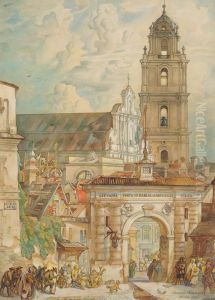Juozas Kamarauskas Paintings
Juozas Kamarauskas was a Lithuanian artist and graphic designer, known for his significant contributions to Lithuanian art during the interwar period. Born on April 17, 1893, in the village of Palonai, near Šiauliai, Lithuania, then part of the Russian Empire, Kamarauskas grew up during a time of national awakening and cultural revival in Lithuania.
Kamarauskas studied at the Kazan Art School in Russia, where he was introduced to various artistic styles and techniques. He continued his education at the Kraków Academy of Fine Arts in Poland, where he was influenced by the work of Polish symbolists and Art Nouveau artists. After completing his studies, he returned to Lithuania and became an active member of the Lithuanian art scene.
He is best known for his work in graphic design, particularly in book illustration and ex-libris design. Kamarauskas' illustrations often reflected Lithuanian folklore, history, and rural life. His style combined elements of symbolism and realism with a strong sense of national identity. He also designed numerous posters, postcards, and stamps, contributing to the development of a Lithuanian national style in graphic arts.
Kamarauskas' career was also marked by his involvement in teaching. He taught at the Kaunas Art School, where he influenced a new generation of Lithuanian artists. His pedagogical work was an important aspect of his legacy, as he played a role in shaping the country's artistic future.
Unfortunately, his life and career were cut short when he died on December 8, 1937, at the age of 44. Despite his early death, Juozas Kamarauskas left a lasting impact on the Lithuanian art community. His works are considered an integral part of Lithuania's cultural heritage and continue to be studied and admired for their unique blend of national tradition and modern artistic expression.
